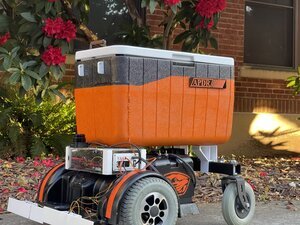
College of Engineering Unit:
The purpose of this project is to create a robotic package delivery system operating in the context of an environment with well-developed pedestrian-tailored infrastructure, such as a college campus. The Autonomous Package Delivery Robot (APDR) will be capable of carrying packages while autonomously navigating along sidewalks and avoiding obstacles to reach its final destination. The scope of this project also contains a user interface in the form of a website that will allow individuals to initiate and receive deliveries at a specified destination. The goal of this project is to join the increasing number of autonomous delivery robots that provide contactless deliveries of food and goods to customers. This project will also introduce a solution to the rising issue of electronic waste, which will be achieved by recycling the base, motors and batteries of electric wheelchairs.
This project was inherited from a previous Oregon State University EECS Capstone group (2020-2021). This team will be working with Hanna Anderson, project sponsor, and previous team member on this project. In its current state, the robot is capable of movement under manual control, avoidance of stationary obstacles, and way-point creation using GPS. The technical goals for the team inheriting this project are developing a secure package delivery system and increasing the capability for autonomous outdoor travel of the APDR. The developed product will be incredibly aware of stationary objects and dynamically moving pedestrians and vehicles, as well as provide an intuitive and reliable courier service to distributors and customers alike.
The robot utilizes several sensors in order to traverse and maintain its course. Sensors include a Light Detection and Ranging sensor, or LiDAR, a Global Positioning System, or GPS, an Intertial Measurement Unit, or IMU, wheel encoders, and switches to act as bumpers. The GPS and IMU work in tandom to determine the course of the robot and to allow for changes to be made based on current position and orientation. The LiDAR unit serves as the primary form of object detection for the robot, allowing it to detect potential collisions and navigate around the obstacles. The bump sensors provide another form of safety for collisions. If the robot were to collide head on with an object and trigger the bump sensors, the robot will halt and cease movement until a user ensures it's safety. All of these sensors are read and processed by an ESP32 microcontroller. The ESP32 then sends the data to the Raspberry Pi over a USB-Serial connection which in turn feeds the data to a topic for the Robot Operating System 2, or ROS2, to compute based on the node which requires the data. Some of these topics include custom nodes developed by the team, including a microcontroller unit processing, USB-to-Serial driver, and the motor controller driver. Once computations are made by the various topics, the robot begins its traversing to its position.
Industry Sponsor(s):
Project Communication Piece(s):
| Attachment | Size |
|---|---|
| 41.21 KB | |
| 223.7 KB | |
| 3.73 MB |